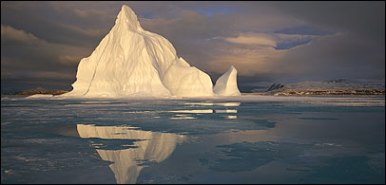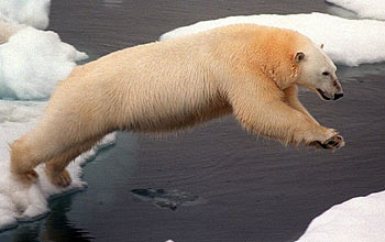Going with Iceberg , Eskimo and Polar Bear in Arctic Canada
Advice and Guide, Wonderful ThingsIceberg , a cruise in the Arctic

What to wear
Wellington boots or something similarly waterproof are essential. It is recommended boots that are 14-16 inches high with a ridged sole as there will be wet landings and a pair of Chameau Chasseurnord boots, with a warm Neoprene lining . You will need waterproof and or woollen gloves; a Gore-Tex or waterproof expedition shell jacket such as the Technicals Hydrotec Men’s Limit jacket ; two lightweight sweaters and maybe a turtleneck; a pair of waterproof trousers; a woollen hat and woollen or polypropylene socks. You will also need a good sunscreen and insect repellent.
A cruise to the Arctic is one of the few true voyages of discovery left for travellers. But the future of this fragile wilderness is uncertain, so go before it’s too late.
It was little more than a speck in the distance but, as peered from the deck, it was a polar bear. After days at sea on an expedition to Baffin Island that had been hampered by fog and rough seas, this was the Arctic moment that is worth waiting for.
As the ship was nearing Akpatok Island in north-eastern Canada’s Ungava Bay and, as got closer and through high-powered binoculars, those specks became clearer.There are bears walking majestically along the shoreline. They didn’t look quite the same as those on the Fox’s Glacier Mint wrappers – their coats take on a grubby, brownish hue in summer – but at last this was proper wildlife. Unfortunately, venturing any closer would have to wait until the morning. Yet again heavy swells prevented the ship’s Zodiac inflatable boats.
Unlike the Antarctic, which in recent years has begun to attract several thousand cruise-ship visitors, relatively few people journey to this stark, beautiful region. Remote, challenging and contradictory, it has a great deal to offer the adventurous traveller.
The Lyubov Orlova, an ice-class, Russian-crewed ship, the previous Saturday in Iqaluit, the capital of Nunavut, Canada’s largest and newest territory, which has been governed by the Inuit since 1999. An Inuit-owned company, Cruise North, is behind these expeditions to the Canadian Arctic. Now in its third year, Cruise North intends to use the two-month summer window (late June-late August) to introduce more people to the region and its wildlife, and to forge a better understanding of Canada’s aboriginal people.
Equally important, the Arctic has become a barometer for the effects of global warming across the world and, as awareness of what is happening has increased, so has interest in the region. This, after all, is International Polar Year. And who better to echo the siren call about the effects of environmental damage than the Inuit? Many we met readily discussed their experiences of rising temperatures and the effects they have had on their traditional hunting grounds – the Arctic is warming at twice the rate of the rest of the world. This has resulted in increased rainfall and receding ice floes (some 14,000 square miles annually, equating to a 40 per cent loss in the past 30 years). Yes, they say, it is partly cyclical, but the changes have become more pronounced, particularly in the past five years. With polar bears already losing their habitat, the predictions became even worse in January, when the experts suggested that the Arctic’s summer ice could have disappeared by 2040.
Iqaluit , this unprepossessing town is more like a scrubby outpost in a modern-day Western. It is dominated by two ugly, white hangars – which turned out to be schools – a supermarket and an unsightly refuse dump on the outskirts. It did, however, have a wonderful museum detailing local Inuit history with photos of fur-clad settlers from the early 20th century, one of them shown playing a piano.
You might see on journey up the Davis Strait to Baffin: whales, walruses, bears, seals and numerous types of seabird and along with Inuit history, culture, language (Inuktutuk) and the well-documented struggles of some Inuit to adapt to modern life (alcoholism is a problem in many towns).
Monumental Island in the Cumberland Sound, a haven for polar bear and walrus – but the fog and the sea weren’t co-operative and there was even an island out there in the mist. No matter. Just being stuck in the middle of nowhere made one feel like one of the explorers who made their name in these lonely seas: a Martin Frobisher, a Henry Hudson or a Sir John Franklin.
When reached Pangnirtung on the northern side of the Sound. At this former trading post for the Hudson’s Bay Company, a party of Inuit from the town would greeted you on board with a pre-lunch (meal times are a frequent part of cruise life) snack of muktuk, raw beluga whale skin. This was as unpleasant and rubbery as it sounds, even though it is rich in vitamins.
Pangnirtung’s whaling museum is a fascinating tribute to a harsh and bloody trade – the Inuit were paid in clothing and tobacco for risking their lives. It is filled with an array of barbaric-looking harpoons together with other facets of Inuit life.
The town is also known for its art, in particular stone sculptures, usually made of sensuous serpentine – dancing polar bears are a common theme. Evocative prints and tapestries are another feature of the local art, which is an important source of income.
A couple of local men demonstrate the high kick, one of many traditional games of agility, while two women performed throat-singing, which imitates the sounds of animals and birds. It sounds more than a little odd but the harmony produced by the two girls was quite beautiful.
Auyuittuq was established as a full national park in 2001 and is one of the crown jewels of the Canadian parks. Expectations were therefore high as we donned our Wellingtons and waterproof gear early the next morning for a hike across the tundra. Dropped on the shore commando-style , a thunderous rock fall from one of the park’s mountains, left behind by the retreating Ice Age glaciers. Along an ancient river bed towards Pangnirtung Pass, the landscape was amazingly raw. Occasionally there’s an opportunity for hardier members of the expedition to camp out overnight.
Passing majestic icebergs, made all the more remarkable by their vivid blue streaks and the knowledge that 80 per cent of their bulk lies beneath the water, and the smaller, sneakier “growlers”, the ship moved on to the island of Killiniq, once known as Port Burwell.
The island, now uninhabited, has been home to numerous Arctic people (due to its sheltered harbour) and more recently it was the site of a fish-processing plant, the debris from which is, depressingly, all too evident. What’s striking, however, is the abundance of flora: the land may look brutal and barren but amid scrub such as the vivid Arctic fireweed, flowers and berries (including crowberry, poppy and saxifrage) can be seen on the rocky ground. Numerous mushrooms and lichens, with evocative names such as witch’s hair and pixie-cup, also thrive, as does scurvy-grass, which sailors used to eat as a source of vitamin C.
On approach to Akpatok, against the backdrop of a stunning double iceberg, a mother bear and cub sniffed around a waterfall. Another family chased down and devoured a hapless, thick-billed murre, thousands of which form great colonies in the rocky hillsides above the shore. It is from these birds (akpat in Inuit) that the island takes its name.
A further exploration after lunch to another part of this moon-like island revealed more treasures: the remnants of an oil exploration site, pretty flowering plants such as the white-flowered avens, a limestone shelf packed with fossil remains and the bones of a polar bear. That night the Northern Lights shimmered a pale green.
It had been a day that shall never forget and all the frustrations of the bad weather were quickly forgotten. This, after all, was an expedition on which nothing, apart from the comforts on board ship, is guaranteed – which is precisely what makes it so rewarding.
